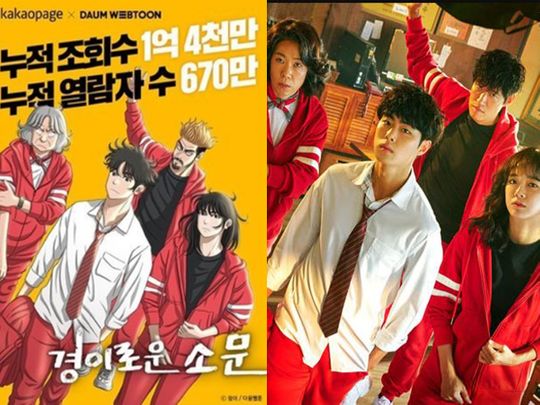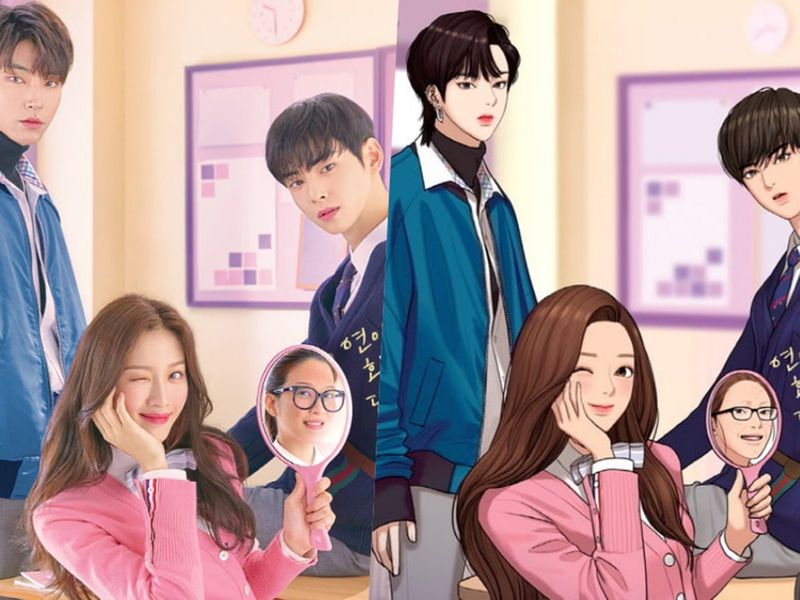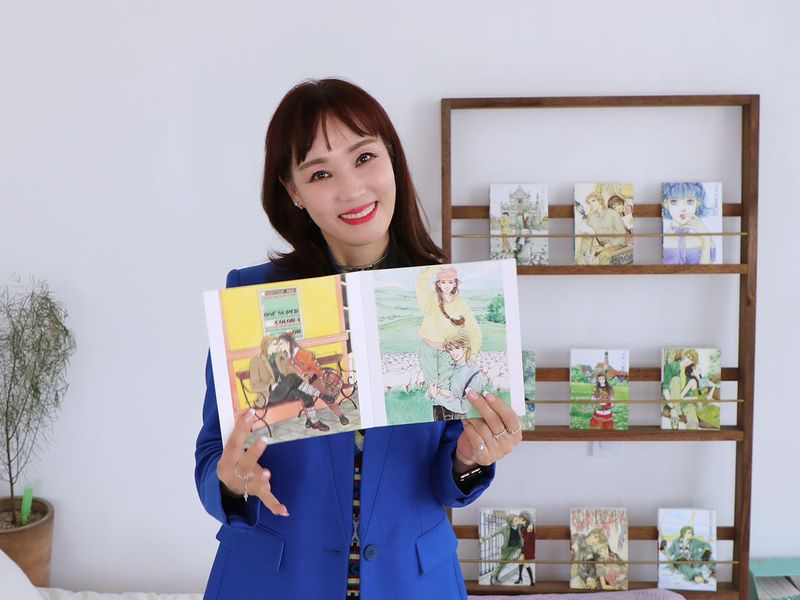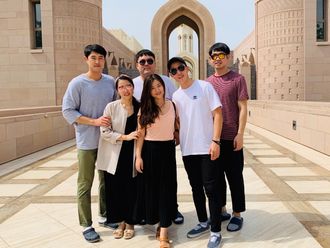
Business Proposal, The Uncanny Counter, D.P., Sweet Home, Itaewon Class, Taxi Driver, See You in my 19th Life… the list of K-dramas either based or inspired by Korean webtoons or manhwa is long. As the audience veers away from the classic chaebol heir-poor girl storylines, the webtoon influence keeps gaining ground with unique plotlines.
“This interplay between webtoons and dramas is further fueled by the considerable number of works currently being produced and developed, which is more than the number of works already aired to date,” Seungyun Ro, from the business team at Naver Webtoons in Seongnam-si, Gyeonggi-do, Korea, tells Gulf News. As a result, the trend of webtoons inspiring Korean dramas is expected to accelerate in the foreseeable future.
Ro also explains that as there is increasing demand for OTT content, especially on global platforms, coupled with the continuous production of diverse webtoon works, these factors foster an environment where webtoon-based dramas can attract a broad audience and expand their global presence. “Additionally, webtoons' visual storytelling format allows for easy adaptation into various content forms, and in some cases, webtoon creators even participate in drama productions, ensuring adaptations align with the drama format,” he says.
BTS fanbase ARMY, might remember the band members embodying roles from the webtoon 7 Fates: Chakho. The original webtoon focused on seven tiger hunters who come together and form a team called Chakho. The highlight in the BTS teasers and photo promotions was of course, Jungkook portraying half-human and half-tiger.
The ominous videos, where all the boys looked menacing and tortured, spurred much discussion among eager fans, who even rushed to read the original webtoon.
On the other hand, for those who revel in the world of Korean shows, you’ll remember the rage surrounding All of Us Are Dead. The 2022 zombie horror series, which saw school children trying to save themselves against a murderous hoard of zombies, is an adaptation of the webtoon, with the same name. The show became a rage and clocked over 474.26 million hours in the first 30 days of its release.
As the Hallyu wave spurs to greater heights with Korean dramas and K-Pop, you can add the cultural phenomenon of webtoons to the power of the Korean wave.
‘Webtoon combines the power of web and comic’
“In Korea, the term ‘toon’ was more commonly used to refer to comic books,” explains Korean manwha artist Won Soo-yeon in an email interview with Gulf News. Based in South Korea, Soo-yeon published the series Full House, which was later made into a television show in 2005, featuring Song Hye-kyo. Elaborating further she says, “The term webtoon is a unique noun in Korea, which combines the words web and toon to represent comics on the internet,” she says. In other Asian countries, the term ‘manhwa’ is generally used for comics. On the other hand, Japan has promoted the term ‘manga’, which is a noun for Japanese comics.
“Just as the term ‘manga’ in Japan, Korean comics have become widely referred to as ‘webtoon’ as a distinctive and unified term,” says Soo-yeon. It is the new culture in South Korea, which combines the power of web and comic, says Seoyeon (Stella) Kang, the CEO of Stella & Inc, a content creative company in South Korea.
However, it has been a rather long and arduous journey for webtoons to achieve the famed status they have today.
The ‘shameful and harrowing’ history of web-toons
In 1996, the first webtoon was published, titled Moo-in-do (Deserted Island) by Han and Hee-Jak, says Kang. “The concept of webtoons was not fixed for a while,” she adds, mentioning that all kinds of web comics published on portal sites and newspapers were referred to as webtoons “Now, when you say webtoon, people think about Naver [webtoon platform] Kakao, as the place to view them,” she says.
Webtoons emerged during the transition from offline to online platforms, which were not created by portals or publishing companies, but by individual artists, themselves. However, it was rather challenging to reach this point, says Soo-yeon. “Webtoons were born with issues like severe copyright infringement, low pay for artists, as well as the perception that webtoons should always be free. In essence, webtoons seemed to be an underappreciated subculture,” she says.
There is a ‘shameful and harrowing’ history behind moving the comics to the web, says Soo-yeon. "One portal called Lycos even made a TV advertisement saying, ‘Are you still paying to read comics?’ This caused significant distress to the comic artists,” recalls Soo-yeon.
Webtoons were born with issues like severe copyright infringement, low pay for artists, as well as the perception that webtoons should always be free. In essence, webtoons seemed to be an underappreciated subculture. One portal even made a TV advertisement saying, ‘Are you still paying to read comics'. This caused significant distress to the comic artists...
As the companies scanned the artists’ works and made profits, the artist’s copyrights were not protected, and their work was indiscriminately uploaded on the web. “During this time, the artists had no knowledge of where their works were being used. As comics began to move into the web environment, artists were already aware of the concerns regarding their copyright violations and engaged in copyright movements, inevitably leading to conflicts with companies,” elaborates Soo-yeon.
The rebellion of the artists
During this process of transition, a new wave of webtoons emerged, breaking away from the traditional and published comics. The web was now a platform for young comic artists to experiment, as well as for those who wanted to interact with fans without any conditions.
They began to upload their work freely to the web space, bypassing the conventional publishing companies. “As new internet terms began to originate, this unrepressed expression reflecting the artists individuality led to the natural formation of their fan-bases, eventually giving birth to webtoons,” says Soo-yeon. The rise of the smartphone era also heralded a new beginning for webtoons. With the introduction of smartphones, the webtoons witnessed a significant expansion as it evolved into a new culture where people could just scroll on their phones to view the comic on the web, explains Kang.
Yet, it was still not a cakewalk for the artists. While many of the changes took place between the late 1990’s and mid-2000s, the artists continued to face dismal compensation, “despite pouring their blood, sweat and tears into the work,” says Soo-yeon. The perception that webtoons should always be free hung over them like a sword, casting a rather gloomy shadow over the Korean markets. However, the artists were firm in advocating for their rights and worked hard to promote the monetisation. Eventually, their efforts bore fruit, leading to the current ecosystem of webtoons, where they receive fees from the platforms. As the platform earns advertising revenue by free users, the revenue is distributed to writers.
Why do webtoons have such a stronghold in Korea?
Just like the way K-Pop idols enjoy interacting with their fans on the platform Weverse, webtoonists interact with fans and viewers from the comment section on platforms. Describing it as ‘two-way communication’, Kang says, “Sometimes the story and character itself is changed. For example, the webtoonist thought of ‘removing’ character A from the story, to move the storyline. However, the fans’ voice kept on leaving character A in and to continue the story,” says Kang.
Sometimes, the webtoonist follows this request from the fans, else his or her views decrease. “This two-way communication between the webtoonist and readers forms a relationship based on fandom, and appeals to their taste rather than one-way contents such as comics,” she says.

It's two-way communication. Sometimes the story and character itself is changed. For example, the webtoonist thought of ‘removing’ character A from the story, to move the storyline. However, the fans’ voice kept on leaving character A in and to continue the story...
Explaining this phenomenon further, a Korean sociology professor from Seoul who prefers to be left anonymous says, “Korean society is a representative collective culture. The concept of collective culture represents that it values groups and communities over individual. This is of course changing rapidly but the underlying collectivist culture still is intact within the society,” he says.
Webtoon is a “hyper-connected” cultural content between individuals as they form fandoms, he continues. Furthermore, the individual, in this case fans, are also connected with the writers and artists. “When you read the webtoon and become a fan, you are not just a reader, but part of the group. This is well represented between people who debate and discuss on the webtoon story and character. They feel included within the content, as they can speak with others that have a common interest,” he says.
K-dramas have haven't missed the hype surrounding webtoons and sometimes woven it into their own stories. A close representation was shown in Lee Jong-suk’s Korean drama W: Two Worlds. In Lee Jong-suk’s revenge drama, he plays the role of a vengeful webtoon character, who ends up in the real world, and meets his own creator, while falling in love with his daughter. The story follows the blurring of two worlds between the webtoon and reality. Fans throng the stores and eagerly await the next twist in the engrossing webtoon, unaware that the characters are actually present in the real world, as they try to escape a serial killer, determined to slaughter them.
‘The dynamism of webtoons’
Webtoons also have a different layout, compared to the original comic style. “It can be much more dynamic and some webtoons use this ‘free’ special layout to make a much more dynamic webtoon piece. This can be found especially on action webtoons,” says Kang.
The webtoon platform is very dynamic and can be used to differentiate from traditional comics and manga, explains the professor. “They can add music, short clips or animation, interactive contents, and most of all the story flow is fitted with the ‘scrolling down’ [nature of phones]. The story, including the text and visuals are well placed, matching the speed on the reader’s scroll speed,” he says. The vibrant colours, sometimes even incorporating music or simple animations, tend to provide an innovative and immersive reading experience that differs from traditional Western comics or graphic novels, adds Kang.
In the social context, trending and something new is always considered “something that needs to be followed” by people with a fear of missing out. “Without being able to follow the speed and trend, it feels as if they are lagging behind. This represents why there is so much webtoon content that fits the ‘dynamical’ and fast paced social status,” the professor elaborates further.
‘Easy to access and free’
While it is easy to access, the main strength of webtoons lies in the fact that there is a wide range of genres. There’s no dearth of choice. “They can either read a short series on the way to work on a subway, or they can read a long series in their free time. Compared to traditional comic books, another advantage of webtoon is that the story can continue like a drama series. The readers wait for the next series, which is usually twice a week, and wait for the next content to be released. Even during their waiting, they can view other similar webtoon series during that time,” says Kang. It is also free access. There are business models of webtoons with paid content, but generally the on-going series with standard release time is free to be viewed.
Moreover, major Korean tech companies, most notably Naver and Kakao have supported and promoted webtoons, helping them to reach a broader audience. “These platforms have actively cultivated webtoon ecosystems, connecting creators to readers efficiently,” says Kang.
The webtoon industry offers a platform for artists and writers who may have been overlooked by more traditional publishing routes, and also targets the lucrative American market. “This democratisation of content creation has allowed for a wider range of voices and stories to be told, driving the medium's popularity,” she says. These platforms have also helped in globalising the reach and extent of webtoons, making them more accessible to Western audiences.
Kang also explains the localisation process that goes into adapting webtoons for a global audience. Here, the main idea is to translate the language and also make it culturally appropriate to the target audience. The process goes through translation, where the original text is translated into the target language. Following this, it is reviewed for cultural references, humour, slang and societal norms that need to be molded into the target context. The visual elements, like gestures, symbols, may need to be altered to be understandable. Some of these elements are explained with the help of footnotes or translator notes. After this, the text is proofread and edited to ensure language accuracy and readability.
The visual appeal of webtoons
Take a look at the What’s Wrong with Secretary Kim webtoon. If you followed the K-drama featuring Park Seo-joon and Park Min-young, you’ll notice how the show has tried to capture all the details from the webtoon, down to the way the main character’s hair is tied. Don’t miss Min-young’s trademark pink shirt and skirt, either; it is exactly how her character Kim Mi-so is represented in the webtoon.
In comics and webtoons, storytelling is not just about the text or dialogue, but also about the visual interpretation of the plot, says Kang. “A well-drawn and aesthetically pleasing image can convey emotions, actions, and subtleties in a way that text cannot. For instance, the artist can manipulate colors, shading, and layout to express a character's mood or to create a specific atmosphere,” she says.
The visual and drawing style play a key role in the fandom, but a lot depends on the personal taste of each reader. “Generally, the webtoon can be split into two large dispositions, feminine and masculine. For example the feminine disposition caters to the romantic genre,” explains Kang. In the ‘feminine’ section, the visuals are designed primarily for women, and more often than not, belong to the romantic genre itself. “On the other hand, masculine disposition, for example, let’s say an action genre – has much more masculine visual styles. These visuals plays a role in gaining the fandom of each group’s preference,” says Kang.
The unique aesthetic style of a webtoon fuses into its brand identity. “Readers can quickly recognise the art style and associate it with a particular artist or series. This can help to build a loyal reader base and increase the webtoon's popularity,” adds Kang.
How do webtoons provide inspiration for Korean dramas?

In 2020, the show True Beauty, featuring Cha Eun-woo and Moon Ga-Young became a raging success. The story, based on the webtoon by Yaongyi, focused on a girl afraid of her own looks, caught in a love triangle between two former best friends. A feel-good mushy tale, the drama also portrayed the thorny problem of bullying in schools. Unsurprisngly, the show was nominated for several awards and later, the creator couldn’t contain her emotions after the success of the show, saying it was a 'dream to see her work being turned into a drama'.
Kang explains why webtoons have inspired so many Korean dramas. “Many webtoons explore social issues, trends, and aspects of Korean culture, making them a form of cultural expression and reflection,” she says. Elaborating more on the aspect of social issues, the professor says, “You can find webtoons that handle trending social issues. For example, Misaeng: The Incomplete Life, which also has been made into drama series handles the issue behind temporary jobs. Songgot handles labour issues. Also some general daily live webtoon series such as Life of Nam intertwines with Korean people’s daily life,” he explains.
“In this context, you can see that many webtoons represent the some topics that Korea people can relate to,” he adds.
This makes webtoons not just entertainment, but also a medium for social commentary and cultural discourse, adds Kang. Webtoons have also gained popularity through successful adaptations into other forms of media, like K-dramas, films, and even video games. “Popular webtoons like Sweet Home and The Deity of High School have been turned into TV series or animations, introducing them to a global audience and contributing to the Hallyu (Korean Wave) phenomenon,” adds Kang.
Some webtoons already have a secure fanbase, which showrunners can tap into. “Additionally, the thorough understanding of the strengths and weaknesses of the original work allows for the possibility of enhancing the overall completeness. Moreover, the ability to enjoy one work in two different styles is also intriguing and enjoyable,” says Soo-yeon.
An artist’s story…

Full House might have attained a cult status now, but the behind-the-scenes process wasn't such a cakewalk in 2005.
Soo-yeon recalls her experience of adapting her series Full House into a show in 2005, a time when it wasn’t common for webtoons to be turned into a drama. “I felt a complicated responsibility. My mind was full of complexities. I had to consider various scenarios, taking into account not only the expectations of the original webtoon’s fans, but also the potential outcomes for success or failure,” she says. She had to contend with much backlash from the original webtoon fans after the casting of Song Hye-kyo was announced. “They claimed that her image was different from the character in the webtoon, and this caused a massive influx of opinions on production and my website, to the point where we had to temporarily close the website,” she recalls.
Finally, she met director Pyo Min-soo, who said that he would make the drama different from the original webtoon. Supporting his approach she says, “I wrote a post encouraging fans to enjoy both versions of ‘Full House’ as it was impossible for the webtoon and the drama to be exactly the same. Finally, the situation calmed down. Subsequently, when it came to casting the male lead, the director and the production team made tremendous efforts. They contacted all top male actors at that time. Since Song Hye-kyo was a rising star at that time with domestic and international recognition, there was an opinion that the male lead actor should be a top actor like Lee Jung-jae, Song Seung-hun, Kwon Sang-woo, and Bae Yong-jun.” However, none of these actors were cast, and finally Rain was cast. “Their chemistry felt so natural and beautiful. Thankfully, the drama was a success. Looking back, Full House was really a turning point for both the actors and myself,” she says.
With translations from Jungyou Kim, Head of Global Communications and Strategy at Communications Korea and E-Wha Kim, manager PR and Media at Korean Cultural center, Abu Dhabi, UAE
(Note: This story was first published on August 1, 2023)












